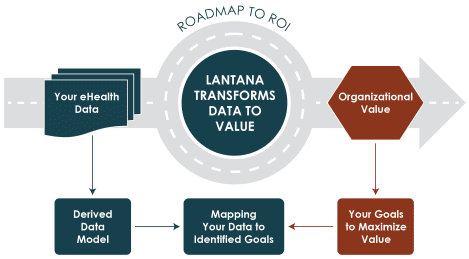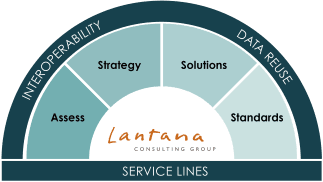eHealth Data and Technology:
Value or Burden?
In healthcare IT, information is often
Lantana Group specializes in health informatics and healthcare data exchange solutions to address these challenges.

Our Answer:
Improving Healthcare:
Transforming Health Information

ASSESS: Health IT Readiness & Data Strategy
How do you chart a path forward that navigates diverse, evolving demands on your data while keeping focus on your mission?
We analyze your technology and assess your readiness for next steps.
STRATEGY: Optimizing Healthcare Data for Interoperability
How do you leverage investments in Health IT to maximize the value of data at the point of care? Which trends in Health IT are priorities?
We develop a strategy to maximize the value of your health data, technology, and time investments.
SOLUTIONS: Clinical Quality Reporting & Data Exchange
How do you implement technology that addresses your needs and follows the changing quality reporting landscape?
We design solutions that increase efficiency of public and quality reporting.
STANDARDS: FHIR, HL7 & Public Health Data Exchange
How do you collect data for maximum benefit, while minimizing cost and rework?
We develop and implement standards that create interoperability and support analysis and reporting.
Methods & Tools
Our health IT analysis methods and tools have grown empirically, organically, over a decade, through hundreds of client engagements in health informatics and clinical data exchange. They continue to evolve in service to our clients and in support of our Solutions.
Data Analysis Methodology
Our data analysis methodology assesses the feasibility of meeting our client’s analytics and reporting goals. We assess our client’s data and goals simultaneously, identify gaps, and make recommendations that take the path of least resistance to meeting their goals. Our methods maximize the value of the data by recommending the most efficient path to meeting analytics and reporting objectives.
See Solutions & Related Blogs
Data Maturity Model
Lantana’s EHR data maturity model is a rating system to assess the availability and variability of electronic health record (EHR) data in live environments, ensuring structured health data exchange and quality reporting. A high maturity rating indicates high availability and low variability of structure and form while a low maturity rating indicates a lack of availability, high variability in format, or structure, or both. Our analysts use the maturity model to assess the quality and availability of data and to evaluate data gaps in production environments.
See Solutions & Related Blogs
Field-Tested Methods for Data Interoperability
Our health data management tools support interoperability, data exchange, and quality reporting, ensuring compliance with FHIR & HL7 standards. These tools are cost-free and open-source with supported/custom versions available:
- Lantana Trifolia: a suite of tools for designing and publishing CDA templates/implementation guides and FHIR profiles/implementation guides. Trifolia also supports CDA validation and the development of bi-directional CDA/FHIR transforms.
- Lantana Validator: a free online community resource that can be licensed for local customization and deployment
See Resources, Related Blogs, & More on Trifolia-on-FHIR for more information on these and other tools and utilities.
Case Statements: Health Informatics & Interoperability
Government

Making Data Useful: A Statewide Consolidated Dataset
Predictable Reporting: 13 sites, 7 EHRs, 65 measures submitted to State Medicaid
Commercial

